|
The vast majority of those who have climbed with us have been through a Rec Climb, Open Climb, or private climb. We love these climbs as they are where most people are introduced to the excitement and reward of climbing tall trees. If you have climbed, you likely reached a point where you were energized by the feel of being high above the ground. This height is quite variable depending on the person, and of course there is much more to experience up there in addition to the distance you are above the ground. Many climbers love the feel of making it up to the branches. For some, just reaching them or touching them is enough. Others like being able to pull themselves over to sit on them. Some have a level of comfort that allows them to stand on a branch and even swing off of them.  Climbing in a Park Near You There is plenty of excietment to be had, even if you return time and again to the same tree; as many of you do with our Rec Climbs in your local park. This is part of the reason why we partner with numerous municipal Rec Departments, to introduce and make the recreational tree climbing experience accessible to as many people as we can. Most people have never seen or heard of climbing tall trees until they saw it in their Rec Department's Activity Guide. Some happen upon us during a stroll in the local park. However you first learned of us, our Rec Climb programs likely played a part with you and your children's introduction to this wonderful activity. 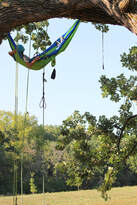 Climber relaxes and enjoys the view during an Open Climb Climber relaxes and enjoys the view during an Open Climb Branching Out Into New Trees We offer our Open Climbs so returning guests can change it up and enjoy climbing in a different tree. Not only do we pick our favorite trees for these climbs, we get to share the experience of hammocking high above the ground. We meet a large number of new climbers at these climbs as well given they are offered on weekends (Rec Climbs primarily offered on weekdays). Under the guise of just another fun thing to do while tree climbing, the hammock actually adds a level of challenge as getting in and out of it while hanging on rope further engages a climber's problem-solving and creative thinking skills. Since our Rec & Open Climbs are open to the general public and do not require experience, our procedures and the situations can be limiting to some climbers.  This advanced climber took advantage of the opportuntiy to climb the facilitator's rope to the top of the tree. This advanced climber took advantage of the opportuntiy to climb the facilitator's rope to the top of the tree. Out on a Limb Our Open-Advanced Climbs cater to people who have already climbed with us. This means that you are likely sharing climb-time with others who have worked through the initial fears and learning curve that limits first-time climbers. Open-Advanced Climbs attract participants who have really taken to the climbing experience and want to do even more up there. Climbers who are more comfortable at-height, would like to try new challenges, and excited to expand our movement around the branches. There are participants who are still working through fears of heights or maybe simply enjoy swinging. The common factor among the participants who come to these climbs is to take advantage of the longer sessions and not having to wait in line. There are more ropes than climbers, fewer people, and everyone has climbed with us previously. That enables us to allow climbers to try advanced challenges and more movement - like walking out further on a limb. We can even have a climbing guide in the tree to help participants work on various skills next to each other. Professional climbers enjoy much more movement and freedom when climbing, whether reaching higher points or more lateral movement and use of the climbing knot. Each month we offer up a new experience that we cannot allow in Rec & Open Climbs. Former students of our learn-to-climb classes are often in these climbs as well, working on the same skills; which makes for an exciting dynamic! Aspiring climbers of all levels, enjoying tree-time together. Each person focussed on their personal experience and intention for the day. For me, these types of experiences are what make the climbing experience more enjoyable, provide greater connection to the tree, and promote personal growth. If you or your child have climbed with us before & would like to continue to pursue the many benefits and rewards of climbing trees, I encourage you to learn more about our Open-Advanced Climbs. They are a great option for those who are too young learn to climb on their own and those not ready to make the investment in the equipment.
0 Comments
There are a few of reasons why certain trees are special to me for climbing. Sometimes it is for the connection I feel to the tree, a particular challenge it may present for climbers, or because it provides an experience unique for those who head into the treetops. I am often asked if I have a favorite tree to climb. It's hard to narrow it down to a single tree, but here are four of them and what I enjoy about them. Each year I select a number of these favorite trees for our Treetop climbs (Open, Open-Advanced, Adult, and Girl Scout Open Climbs). Here's why they are special to me and may help you decide if you'd like to climb it with us. Pearl 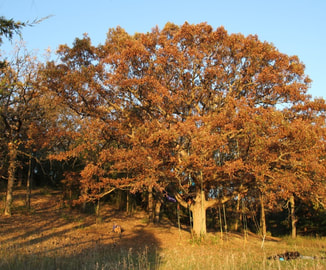 Pearl in fall Pearl in fall Pearl is one of my favorite trees. Growing at the base of a ridgeline formed during the last glacial period, this white oak is one of the older trees in the stand of oak & hickory overlooking the restored prairie. While understory plants have filled in the oak savanna that stretches the length of the ridge, park management is returning the area to the splendor of the natural savanna and prairies common to southeast Wisconsin in it's pre-settlement days. (Pearl is our climbing tree in Mukwonago Park) Having grown in open sun in its younger years, Pearl has developed a broad spreading crown with numerous large branches, an eye-catching form, and a broad trunk that is firmly rooted in the fertile soil. The number and span of the branches are part of what make this tree an enjoyable one to climb. There are several branches to explore and plenty of comfy spots to lay your head back and enjoy the hours pass by. 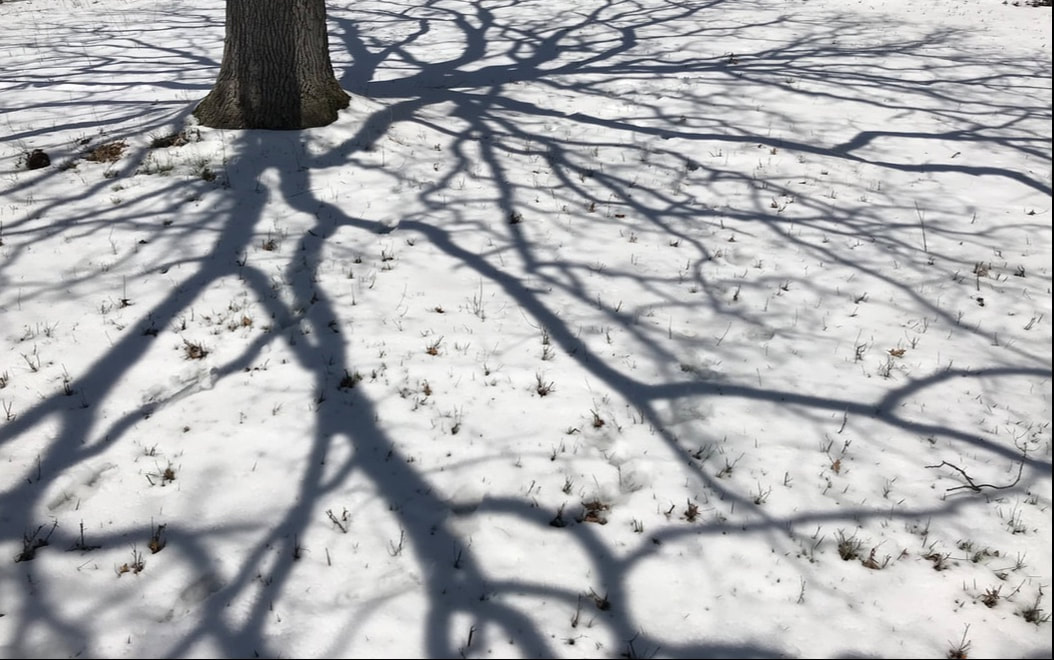 Pearl branching structure Pearl branching structure Taking time to look at the other mature trees along the hillside surrounding you, you can still make out the structure of the savanna before the understory and invasive plants crept in. Climbing late in the day may provide the opportunity to enjoy the rays of the setting sun. Winter climbs are a treat when the sun casts shadows of the weaving branches on the ground below. After taking time to play in the branches, you can head to a special place at the top. A fork in the branches at the very top form a small cradle that you can stand in, placing your head within feet of the uppermost leaves. Looking south, an opening in the branches provides a window where you can take in the view of the horizon. That is one of my favorite places to be in Waukesha County. The Woodfield Oak Since first meeting this tree in Woodfield Park after moving to Waukesha over 20 years ago, I have returned regularly to sit in its shade. It has often served as a place to quiet my mind and enjoy my lunch break. The form reminds me of the live oaks that grow in the Southeastern U.S. with their sprawling branches. It is about 55 feet tall and the branches reach out about 85 feet from tip to tip! Two large lower branches scoop down to the ground, ready to embrace you like outstretched arms. It is a special tree…and why I have not found the right name for it yet! The tree is upwards of 200-225 years old. Having sprouted from an acorn in the late 1700’s to early 1800’s, this tree was already a modest sized tree by the time Wisconsin became a state in 1848. With broad spreading horizontal branches, this tree is a favorite amongst climbers as they allow for long limb-walks and great for taking big swings on your rope. Since peoples’ comfort with heights varies, I love introducing students and public climb participants to the tree as there are great branches to practice skills or play from 7 to 40 feet above the ground. As the crown spreads and trunk heads towards the sky, two main stems form to provide a pair of high points in this tree. Reaching the top of either one, you will find yourself standing with your head near the uppermost leaves of this amazing tree. Captain Tony Fox Brook Park features a number of beautiful bur oaks & our particular climbing tree grows near the bank of the lake. Captain Tony is a great tree, providing shady branches to get out of the summer heat and enjoy refreshing views of the swimmers and kayakers on the lake below. With an upright trunk that forks into a few limbs, there are some great spots where you can pause and explore. Some of the branches allow for swinging and a taste of moving about the branches.  Kicking back in Captain Tony Kicking back in Captain Tony Captain Tony has a nice trunk route, which is when your climbing rope hangs down alongside the trunk. I enjoy trunk routes because I can touch the large limbs, feel the bark, and form a closer connection to the tree. For many climbers the challenge presented by being against Captain Tony's trunk may prevent them from making it past a particularly tight spot on the way up. Those who are able to adjust their ascent technique, use the trunk to their advantage, or able to persevere with determination are able to get past this point. Once above it, you are rewarded with a chance to stand at the point where the large limbs begin to form the crown. Standing there, energized and beaming with satisfaction, you will look up to find a clear route to the top. Watching others successfully make it past that difficult spot and seeing them beam with pride for the accomplishment is a highlight of the day for me. A Boost Up It is not always about finding the tallest tree to climb. Most of the time I am looking for an experience or something unique a tree may provide. The swamp white oak in Horeb Spring Park is a pretty tall tree for our area, but where it is growing provides something that all climbers can experience regardless of how high we like to or are able to climb. The tree grows on a hillside that makes for a popular sledding spot in winter. From spring through fall, this slope presents a unique experience for our climbers. As soon as your feet leave the ground & you are hanging on rope, the slope is no longer a concern for you. What it does do for a climber is change your perspective of height depending on the direction you are facing. Facing up-slope you can see the ground and may not feel anything different than when climbing trees on level ground. As you rotate and the view down the hill comes into your field of vision, you feel an interesting sensation of being higher than you actually are.  Hammocking at 20feet with the sensation of being about 40 feet from the ground Hammocking at 20feet with the sensation of being about 40 feet from the ground With trees growing at the bottom of the hill, when you look directly across to them you will be peering into higher points of those trees. Your senses will make you feel that you are just as high in your own tree. That sensation paired with the fact that you can still climb high in this tall tree will you give a boost of energy and allow you to check your comfort with heights. The sensation of feeling higher than you are is due to your orientation relative to the surrounding trees and landscape. This is something I look for when heading out to climb trees in the forest. Walking a ridgetop, I don’t necessarily need a tall tree, I just need a tree that can provide a view over or between the tops of the trees downhill. We often drive or hike to cliff tops to enjoy the view. With rope and saddle in hand, I just need to find a good tree on top of a ridge, cliff, or hill to get that extra boost above most people's perspective.. (Note: some of the experiences and climbing techniques described above may not be available at all Treetop climbs. Advanced techniques like limb-walking or multi-pitch climbing to get to the very top are covered in our Learn-to-Climb classes and introduced with modifications in our Open-Advanced climbs. Open Climbs feature a hammock.) Some people take on exciting and risky endeavors such as wingsuit flying, base jumping, and free-climbing rock faces. You might have even tried a few yourself. Maybe bungee jumping or skydiving? Extreme sports tend to involve activities that take on higher associated risks, thereby increasing the level of danger for the participant. Often times the risks are increased through elevated levels of speed, height or mental and physical exertion. Participating in these types of activities produces a rush of the epinephrine in the body, the hormone associated with the “adrenaline rush.” The “adrenaline rush” is experienced as a reward by some people and thus creates a drive to participate in extreme activities. What might be extreme to you may differ greatly from the next person, therefore we each experience adrenaline rushes at different levels of participation in the same activity. You can experience the rush simply by stepping outside your comfort zone. One Step Over the Line On occasion I am able to get out with a friend to climb rock. Since all of our climbing is done on rope, we hike to the top of our chosen rock face in order to set up the top-rope system. Once he has all the gear in place, we take the shortest route down…stepping off the edge of the cliff. Stepping off the side of a cliff is not part of my daily routine; therefore, I find it quite exciting. It tests my nerve every time! Once over the edge and hanging on rope, rappelling 50 feet down the side of the cliff is relaxing comparatively. Then there are people like Alex Honnold, who free-climbed El Cap. No harness, no rope. To put it into perspective, the wall routes at Adventure Rock reach just over 40 feet and our highest ropes in our climbing trees tend to be between 40-55 feet high. The El Cap route Alex climbed was 3,000 feet. Chills ran down my spine as I watched his journey in the 2018 documentary, Free Solo. I feel an adrenaline rush just thinking about it! As I stand at the base of a cliff or wall and look up, I recheck my safety system. Did we inspect all of the equipment? Is the fall protection system installed properly? Do I trust my belayer? Until my confidence level increases during an ascent, I feel adrenaline release in my blood stream. It is invigorating. Even if we might have grand visions of accomplishing feats like Honnold or simply jumping out of a plane to try skydiving, we know we lack the ability and usually the equipment to do so. Or maybe we’re just a bit more cautious. Do Something Out Of The Ordinary Ziplining and High-ropes courses tend to elicit an invigorating adrenaline rush in many people. We are faced with the fear of falling. If you already have a fear of heights, the effect can be more intense. While tree climbing may fall in the same arena of adventure activities like these, it tends to elicit different responses. Since climbers are in control during their time above the ground, you tend to experience less of an adrenaline rush, yet still feel energized and invigorated. This feeling is likely caused by the release of hormones such as dopamine, serotonin and endorphins. These are some of the “happy hormones” as they provide a boost of feel good energy, without the stress-related impact of the adrenaline rush. For most people, just getting ourselves off the ground is stepping outside of our comfort zone. This where the thrill of the climb begins. Those energizing hormones begin to release. I find it particularly enjoyable when these hormones are at greater levels than adrenaline. As you climb higher, you will eventually encounter the height that registers for yourself as one where you are no longer near the ground. Meaning, you are acutely aware you have stepped outside your comfort zone. For many people this height is reached about 10-15 feet, and maybe 30 feet for others. With tree climbing, you are in control of your next decision. Once you reach that first ceiling, what is your next move? Climb higher, hang out and enjoy the comfort of hanging in your saddle, head down? Once acclimated to the distance above ground, most people opt to climb higher. Decide to climb higher, you’ll feel another flush of those energizing hormones. This process repeats during your climb. When you reach the lowest branches of the tree’s crown. Getting onto or off of a branch, questioning whether you will still be held aloft during each transition. When you reach the top of your rope. Each time receiving a flush of energy. What Level of Extreme Are You Looking For?
Recreational tree climbers live around the world and come from all walks of life. Many head out in search of the tallest trees in order to reach heights of 200-350’. Some are looking for trees and vistas in remote locations, taking them into jungles and rainforests shared by pit vipers, stinging insects and other critters that can cause harm when encountered. Climbing arborists work in the trees daily. Their work requires precision skill to situate themselves into a proper working position to avoid straining muscles or being hit by the piece of wood being removed. Their work might involve operating a chainsaw with the chain rotating near 60mph as 1,400 cutting teeth pass by a specific point per second. Can you picture yourself in either of those situations? Do they seem a little more extreme than climbing the tree in your backyard? Maybe you have tried or have seen a tree climber limb-walking, where they walk out towards the end of a branch. In doing so, they are no longer hanging directly under their suspension point; therefore, now relying more and more on their ability to balance their weight on the branch. The awareness is very much present that if they slip, they will fall & possibly swing uncontrolled towards the trunk. I mention all of this to put into perspective that many tree climbers experience and are often driven by situations that provide an adrenaline rush during the climb. The work is demanding, very rewarding, and ultimately provides the thrill that some of us spend our money on for recreation. Do you think of yourself as someone who is not ready to throw caution to the wind and truly willing to risk severe injury or death? It is fortunate, then, that you can search out experiences under more controlled circumstances where those consequences are not at stake, and push the limits of your comfort zone at your own pace. I take a lot of pictures during our climbs. The experience is different for each climber, each person benefiting from it in their own way. Describing the different benefits that come from climbing trees can be difficult. But you can see it for yourself in this week’s video. Register for a climb today and come experience it for yourself! Warning: Playing outside can cause bruised arms, scraped knees, stubbed toes, dirty hands, stained clothing, muddy shoes. You will get wet when it rains, cold when temperatures are low, and hurt when you fall. Some people may require band-aids, ice packs, or loving arms to hold them as they cry. Life is one huge adventure for those who aren’t afraid of getting dirty. There are many places to explore, limitations to discover, and life lessons to learn. If we don’t learn them as children, then our road ahead will be hampered. Do you ever look back on your own childhood and feel grateful for the experiences you had and the lessons you learned when you were younger? You did not become the strong person you are today in spite of the challenges you faced, but rather because of them. I found it humorous, if not annoying, when my father would say, “when I was your age, I had to walk 5 miles to school.” My typical response was to roll my eyes, as that was what all old people said. These days I catch myself thinking and saying some of the same things! In reality, every generation thinks the next generation has it easier and aren’t as capable of dealing with hardships as they were. This has been going on for 2,000 years! (Check out this article: Proof That People Have Always Complained About Young Adults The more I consider the implications related this line of thinking, I think what we are really saying is that we are grateful for the challenges we had to face when we were younger and the leaders who provided encouragement and opportunities for me to do things for myself. This includes parents, teachers, and coaches. Facing Challenges I typically set up a number of ropes during a climbing event, each presenting different challenges for the climber. If your climbing rope is away from branches and hangs unimpeded from the top anchor point to the ground, your primary challenge will be dealing with your height above the ground and associated fears. By placing ropes so they hang near branches, you will face the challenge of maneuvering past the branch. The closer the rope is to the branch, the more difficult it is to climb around it. At one of our climbs this past summer, a young climber was climbing one of the more challenging rope routes of the day. The rope the young climber was on hung against a branch. With her weight on the rope, the rope rubbed snuggly against the branch above her head. Since her ultimate goal was to reach the top of the rope, well above this lower branch, she was going to have to get herself around it. Since the climbing knot slides up the rope that ran against the branch, she would need to pull the rope away from the branch in order to slide the knot around and above the branch. Until the knot was pulled away from the branch, there was a pinch point. In trying to get past the branch, she got her hand pinched between the rope and the branch. Ouch! She tried again. After a few attempts and just as many scratches on her fingers, she was beginning to get frustrated. After providing her with a few calming and encouraging words, she took a moment to analyze the challenge. Looking back up at the knot and impeding branch, she considered an alternative strategy that could potentially get her around the branch. Taking time to reassess the situation trying out an alternative technique was all she needed to figure out how she could overcome what seemed to be an insurmountable challenge. While her goal that day was to reach the top of that rope, the value of the climb happened along the way, and required a few scraped knuckles. She enjoyed her view of at the top, but she felt empowered and more self-confident because she was able to work past that lower branch. I am confident that the lesson she learned in the tree that day will stick with her as she faces challenges in school and work in her years ahead. Even more important, I hope she has the opportunity to encounter similar challenges often, for that is what will make her stronger and better prepared for what lays ahead. Learning On Our Own Often times adults are tempted to swoop in and offer up a solution as soon as we see a young person encountering an obstacle. With our life experience, I could picture the forthcoming pinch point for the young climber trying to get past the branch. In trying to help out, I could have interrupted her mental engagement and told her precisely how to avoid the obstacle. In doing so, I would have robbed her of the learning opportunity. However, we can only learn so much from listening or watching adults and leaders. We must do it on our own. Parents, teachers, and coaches are constantly balancing how much to help and how much to step back. Our role is to offer up and pass along knowledge to our children or students. It is up to them to take these tools and apply them to their own experiences. In order to teach a person how to climb up our ropes, our responsibility is to explain and demonstrate the knots and technique used to ascend. Then we need to step back and allow them to try on their own. They will make mistakes. They will move and process slower than us. This is the learning process which involves and extraordinary amount of activity going on inside the mind and body of the climber. The length of time required varies significantly between people and is greatly influenced by previous challenges they have faced and gained wisdom from. Should they make a mistake along the way, I have 2 basic options: correct them immediately or allow them to proceed. Ramifications of Rescuing If I jump in right away and correct them, then the lesson I am likely teaching them is that they can rely on me to help them through a struggle. They will eventually pick up the technique, but it usually takes much longer as they are not having to work through the steps on their own. Even if they want to figure it out by themselves, their mental process is derailed the moment I give them the answer. One issue with this approach is that I begin to anticipate when the climber is likely to face a struggle. Worse yet, I am then tempted to offer up the solution even before they are aware there is a challenge. Can you see how catastrophic this approach can be? We can deprive the climber of the opportunity to process and problem-solve because the solution is being provided to them before their mind even encounters the struggle. Freedom To Figure It Out
In contrast, if I allow them to proceed, they will soon figure out they missed a step. While it may look to bystanders that they are sitting there not knowing what to do, they are actually quite busy inside their head. They are processing through the information they gathered during my presentation and demonstration, then trying to figure out how to move their body in order to replicate the technique. They will figure it out. When they do, that is the moment they will have not only learned the process, but also became self-reliant, problem-solved, gained confidence, felt satisfaction, and built positive self-image. It is a challenge to determine the appropriate level of guidance to provide each climber. I strive to provide positive experiences as I do not like to see climbers become frustrated. The point of frustration triggers responses that are detrimental to a person’s learning process and obviously the enjoyment of the activity. Of course, there is a point at which we need to intervene in some manner. I just try to keep in mind that my ultimate goal is to help them learn how to do it on their own, not micromanage them to the top of the rope. It is fun to get to the top. It is rewarding if you do it on your own. Free play Bumps and bruises happen in all kinds of activities. They are part of the learning process. Not only should we not forget this, we should facilitate opportunities for girls and boys to face physical and mental challenges even if that exposes them to scrapes and scratches. With most anything we do, there are dangers involved that need to be addressed for safety. Once we’ve been able to set the parameters that help minimize the associated risks of severe injury, we should then encourage and allow children to have the opportunity to play freely. I am thankful for the knowledge my parents, teachers, and coaches provided me. I am even more grateful that they allowed me time for free play in order to practice, play, and work through the ways in which I could apply that knowledge. Bumps and bruises are often signs of growth and a lesson learned. Each scrape encountered plays an important role in developing creativity, self-confidence, problem-solving skills, and a positive self-image. Let’s not deprive kids these days of these important opportunities to grow! 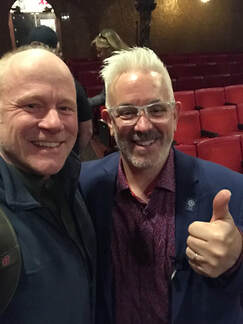 Curt and Dr. Gathright Curt and Dr. Gathright Dr. John Gathright was an author and motivational speaker, not a tree climbing expert. He wrote a book about pursuing your dreams, and at one of his book signing events, he was approached by a woman. Speaking from her wheel chair, Toshiko Hikosaka told him of her dream to climb the world’s largest tree and that she wanted him to help her. He was not a tree climber and had no idea how to climb such a tree, but he wanted to help her achieve her dream. Three years later, Gathright and Hikosaka reached the top of a giant sequoia. At 63 years old, she was the first paraplegic to climb a tree to this height. Her climb that day culminated in triumph, wonder and exhaustion. They spent the night in the top of that 243-foot tall tree, on the branches, under the stars. Just as that day in the bookstore had set the ball rolling for their 3-year journey, the climb to the top of the sequoia was the beginning of the next chapter. Upon returning to Japan, demand for Gathright’s tree climbing adventures inspired him to cut his own path forward. Given there were no tree climbing schools in the country at that time, he had to start at the very beginning. It was a delight for me to be able to attend a presentation of Dr. Gathright recently. He is a pioneer in using recreational tree climbing in therapeutic and rehabilitation programs, and I have been inspired by his work for a number of years. To hear him tell his story of the legwork he had to go through was amazing. Sometimes It Is About The Numbers He had to find research that supported his idea of establishing tree climbing as an effective and legitimate form of therapy. No research existed at that time, therefore he realized his next course of action was going to have to be the pursuit of his PhD studying and testing his hypothesis. His doctoral thesis looked at the physiological and physical differences in individuals between their climbing living trees and climbing a concrete structure. In both instances, participants were climbing to elevated heights and performing similar tasks. In analyzing the data, there were clear differences between the 2 experiences. When climbing trees, participants experienced less pain and fatigue, experienced greater vitality and clarity of mind, and reported feeling a greater feeling of self-worth versus when they were climbing the concrete structure. Tree climbing had produced an increase in positive emotions and reduction in negative emotions. His further studies revealed and measured reductions in participant levels of stress, tension, anxiety, depression, and anger after climbing trees. Not only did his research show the positive effects of tree climbing, it revealed that it wasn’t simply the climbing that was providing the benefit. There was a marked enhancement of the effects when the participants were climbing trees. Gathright had provided the scientific basis behind his TreeHab and Tree Therapy programs. Meet Your Therapist My first ascent of a tall tree early in my career had a profound impact on me physically and mentally. My muscles enjoyed the physical exertion, but I was exhausted. I was energized by the height I had reached, at the same time nervous. Through all of the hormones flushing through my body, I found mental clarity and focus. I was energized, yet I was at peace. I never measured the effects to confirm in what ways and by how much climbing trees changed me, yet I walked away from that climb relaxed and inspired. And every climb since. Over 20 years later, I came across the research of Dr. John Gathright that identified and quantified the effects of climbing trees that I had personally experienced. From its origins in 2000, TreeHab has worked with thousands of children with physical disabilities and emotional trauma. Gathright and Tree Climbing Japan have helped over 300,000 people of all abilities discover their inner tree-climber. As I listened to him share his stories of people he has worked with over the years, I was reminded of those who have touched me during my journey thus far. Tree Climbing Touches Lives I am involved with tree a climbing program for urban youth and people who do not have the resources to leave the concrete and asphalt landscape at will. Counselors and therapists utilize our climbing experience in their dealings with children facing emotional trauma, such as that related to the loss of a parent. It was interesting to hear him speak of programs developed for people with autism and ADHD. While the experience and benefits of tree climbing have a profound impact on these participants, it appears that TreeHab is also having a promising impact on breaking down the stigmas associated with them in his community. I have seen the benefits first hand in dealing with a variety of people from all walks of life and backgrounds. While the majority of our climbers may not fall into any of these categories, every one of us benefits from the same effects that tree climbing provides. His words brought into focus for me that we each have our own inhibitions, insecurities, and unique qualities. Each of us may be at a different point in our journey through life, come from different backgrounds and face our own challenges; but, every one of us can reap the benefits of time in the trees. Stability provides comfort. Dealing with feelings of instability can provide for personal growth. Come along as we look at the tree climbing experience and the ways we transfer our feelings of security and stability from rope to branch. A discussion of Stability and Instability - how to enjoy your climb even more.  Feeling stressed? Looking to escape? Need a break from the demands for your time? It sounds like you could benefit from a change in altitude. This past winter, Jen and I spent time on a tiny island off the coast of southern Florida. The 10-acre island had a handful of cottages, a walking trail, a restaurant, and a few chairs down by the water. No television, spotty cell service, and limited Wi-Fi access. We rented a skiff one day to get to a neighboring island to enjoy a desolate beach. We saw more dolphins, sharks and stingrays than people that day. The week gave us time to talk, sit, read, write, nap, and enjoy our time together. It was quiet. We were relaxed. Trips like these can be a great way to decompress and recharge. They are a small part of the life component in the “work-life balance.” Returning Home Whether it is during your return flight, the moment you reclaim your suitcase or walk through your front door, there is probably a specific moment where your mind jumps back into your responsibilities and your To Do list. Vacation is over. Even if that line for you is blurred more than the picture I describe, and I hope it is, there comes a time when you find yourself back in your daily and weekly routine. It is a feeling similar to wading across a stream. You start by heading into the water, eventually finding yourself in the current. You are focused on heading in the direction you’ve set your sights on, yet not fully aware of the gradual increase in energy you are expending to keep your footing and head above water. At times, the current may pull you off course slightly. Your drive gets you to the other side, but you are exhausted. Wouldn’t it be nice to take a break when the current of life seems to be unrelenting? Fast-forward to the next vacation? Thankfully the current fluctuates. Some days are easier and more productive, others are more challenging. For you, it may seem like months before the current lets up. It might not let up until summer break. Or perhaps the slow-season in your industry, as in mine, doesn’t come until winter. Thankfully, not even 15 feet above the ground, lies the same peaceful escape. Days Like These I do not like to wish my life away. It will pass by soon enough. That’s why I love having the ability to change my altitude when stress seems to be building. It only takes an hour or two out of my day to climb to a different level, and the benefits are often as great as a week in the tropics. Up there, your mind will find peace. It’s as if the worries of ground life are restrained by gravity. As your attention turns towards the mechanics of climbing the rope, your mind is left with little room for outside worries. All of that weight falls from your shoulders relatively quickly. By the time I reach my resting branch, it’s as if I flew back to the island. The sounds of the palm fronds in the breeze and ocean waves lapping against the mangroves are replaced with the rustle of the oak leaves unfurling ahead of the upcoming growing season. An assortment of birds singing and squirrels chirping help me connect to the present moment. My senses are consumed with an appreciation for the unique perspective from where I sit. The tree holds and protects me from the chaos below. Time is of no concern when you spend time in a tree. The breeze, movement of the leaves, and connection with Nature’s energy will consume you. The change in altitude brings with it a change in attitude. This all happens without intentional thought. You enter tree-time as if entering a 3-dimensional field of energy. You can climb trees for something to DO, but most of us discover it is actually a place to BE. Grounded When you return to the ground and get your land legs back, you begin to realize your worries and demands are waiting patiently. One by one, you pick them up and head back into your daily routine. Nature is in no rush. The trees carry on about their business. They will await your return. Most of our Rec Climbs are hosted by municipal recreation departments. More times than not, you will find these climbs listed in the youth section of their activity guides, which may give the impression that tree climbing is for children. In reality, tree climbing is enjoyed by people of all ages. Tree climbing is for people who want to stay young at heart and of healthy mind. Come out and enjoy the benefits of a change in altitude. One of the more common fears people face is the fear of heights, or fear of falling. Come along with me as we take a look at ways tree climbing allows you to challenge yourself and overcome these fears. Click below to see how to take steps to lessen your fears. 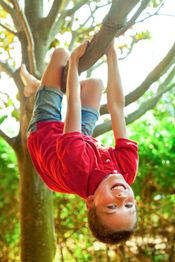 Source: Dmitry Naumov/Shutterstock Source: Dmitry Naumov/Shutterstock Researchers have measured the benefits of activities like tree climbing. They found that the perception of movement as you use your mind to navigate through the tree, and operate your hands and muscles while climbing, has tremendous effects on your cognitive abilities. The improvement in working memory is one of the skills they measured to have marked improvement. Read more at Time.com. For those who like a more technical discussion, read about it at Psychology Today. |
AuthorAs a G.O.T.C. Recognized Master Instructor & Facilitator, I.S.A. Board Certified Master Arborist, and T.C.I.A. Certified Treecare Safety Professional, Curt has spent over 30 years dedicated to the study and care of trees. Categories
All
Archives
May 2024
|
|
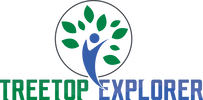


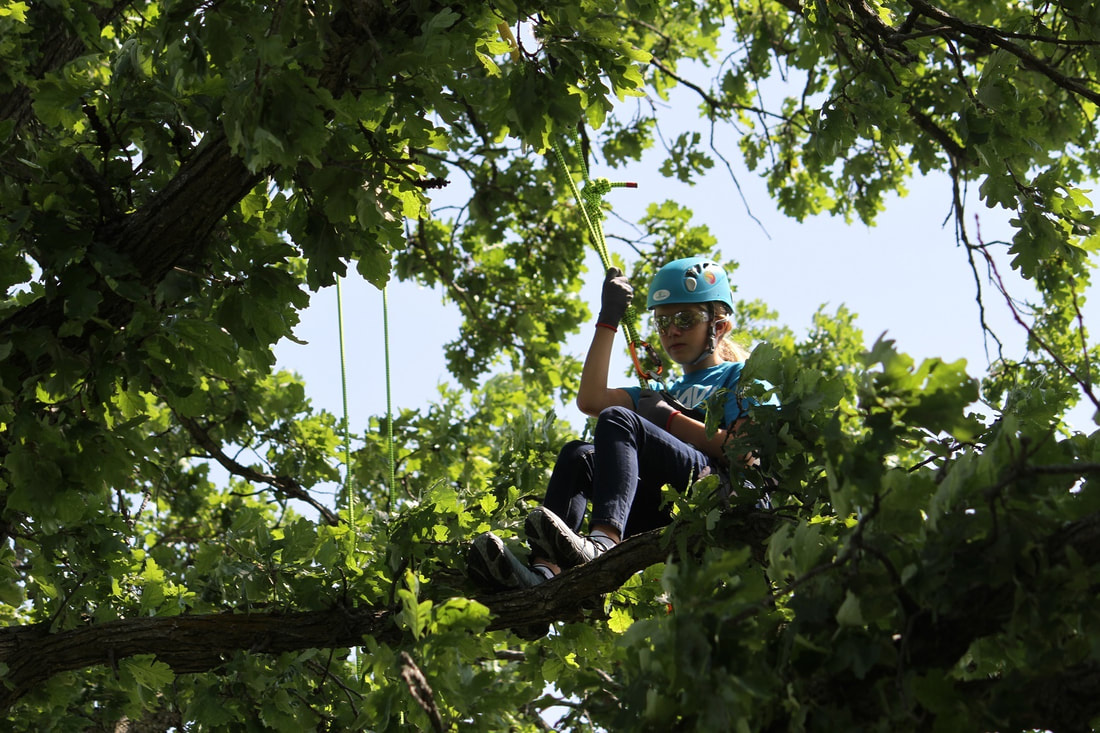



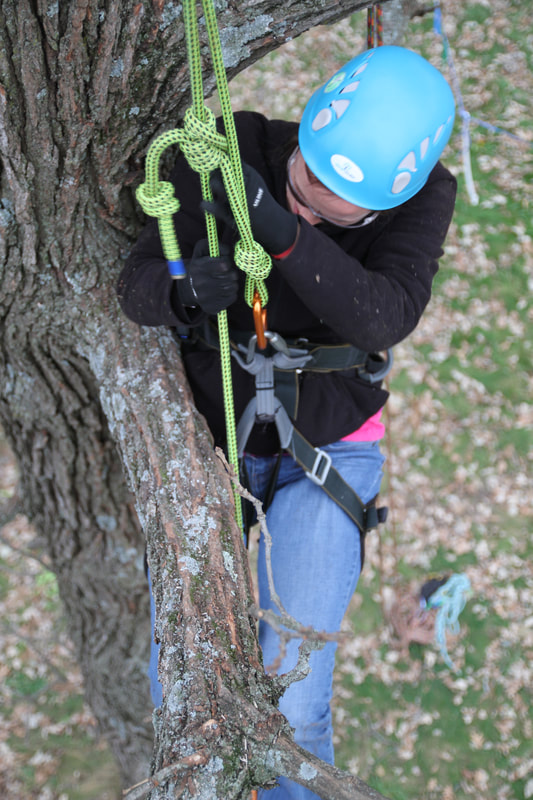



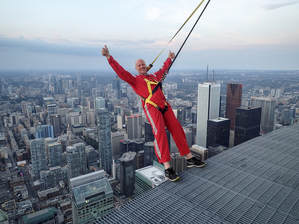

 RSS Feed
RSS Feed
